On 19th August a firm called Caledonian Building Surveyors Ltd submitted a Screening Request (see here) to Highland Council on behalf of the Pitmain and Glenbanchor Estate Ltd. It asked if an Environmental Impact Assessment was required before they could upgrade and create new tracks and upgrade part of the public road up Glen Banchor “to facilitate forestry extraction and a conservation project“.
Bringing beavers back to Glen Banchor?
The brief application form doesn’t explain what the conservation project might be, although intriguingly the application form does refer to “Beaver Dam creation”. If the Glenbanchor Estate is hoping to save some of the Tayside beavers from NatureScot’s licensed culls (see here) that would be most welcome – even if it will be news to most people that beavers need tracks to create dams!
If there are currently enough trees in suitable locations in Glen Banchor to enable beavers to build dams that raises even more questions about NatureScot’s financing of three enclosures for tree planting in the glen (see here). Rather than trying to improve the quality of water in the river at considerable cost by tree planting and importing tree trunks to place across the river bed, wouldn’t it have been much better to let nature, in the form of beavers, do the job?
But that would have meant NatureScot – and indeed the Cairngorms National Park Authority (CNPA) – being brave enough to challenge the Scottish government’s senseless ban on beaver translocation within Scotland, while allowing Scottish beavers to be moved to England.
Whether beavers are re-introduced to Glen Banchor or eventually colonise the glen themselves, their prospects and beneficial impact would be far greater if red deer numbers wre reduced. That would allow natural regeneration of woodland up main glen and its side glens and enable beavers to move and build their dams further upstream, reducing water flow into the River Spey below and thus mitigating the increased risk of flooding being caused by climate change.
What road work is proposed?
There are no details of the proposed road work in the Screening Opinion, only a map without a key:
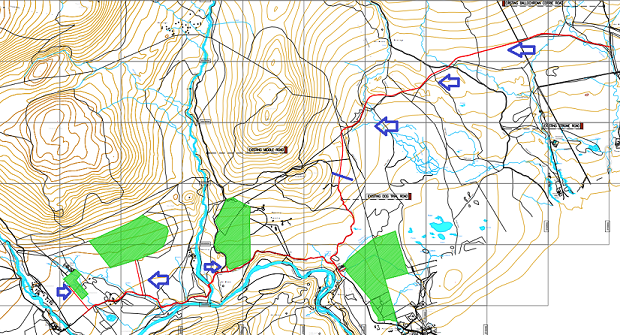
The four patches of green appear to show the blocks of forestry where trees are to be extracted and the red line the proposed road. This is highly misleading, making no distinction between the public road and track beyond that, which already exist, and the sections of new road. More specifically, the length of road above the blue line does not exist at present and is not needed for wood extraction. Rather, it appears part of an ongoing attempt by the very rich owner of the Pitmain and Glenbanchor Estates to link his two properties with a new private hill road (see here) and (here).
That process started with the unlawful bulldozing of a new road along the crest of the fine esker above Newtonmore. After the Cairngorms National Park Authority insisted on a retrospective Planning Application (see here) and required the estate to undertake extensive restoration work, the road appears better than it did four years ago:
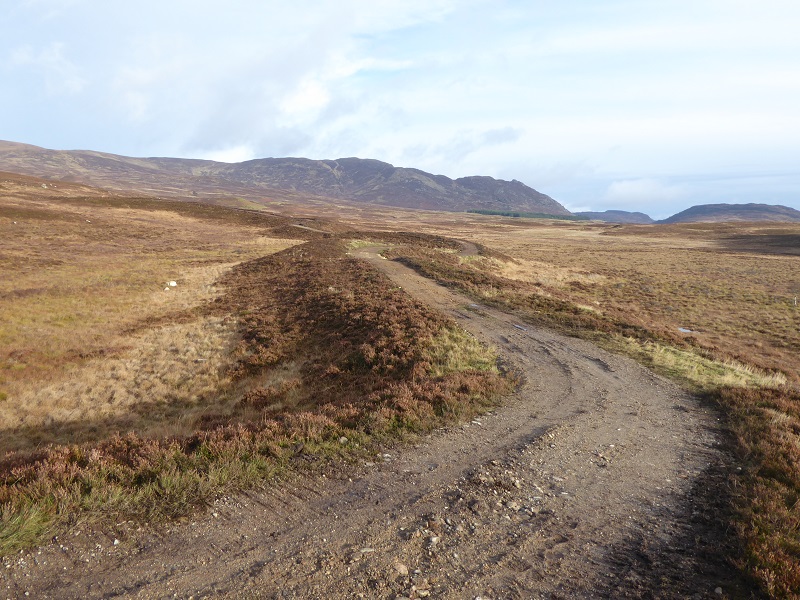
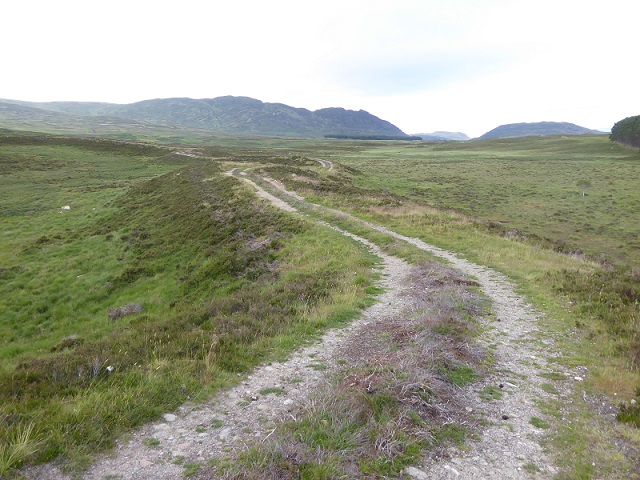
While the justification for this new road was to facilitate sheep dog trials, it extended beyond the area used for that purpose. Unfortunately the CNPA failed to require the Glenbanchor estate to restore that extension and it now could form the first part of the new road that the estate wants to construct over to Pitmain:
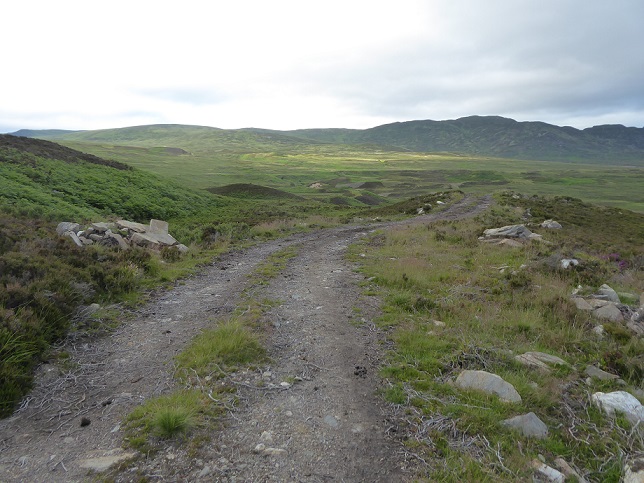
The lesson for the CNPA is cede an inch of new hill road to most sporting estates and they will come back for a mile. A relentless war of attrition being waged against the CNPA’s policy presumption against hill roads in their current Local Development Plan.
What needs to happen?
Unfortunately, there is no facility for the public to comment on Screening Opinions in our current planning system and because this is “only” a screening opinion about whether an Environmental Impact Assessment is required, the Cairngorms National Park Authority does not have the right to comment either.
While the application is unclear about what opinion is sought from Highland Council, the most likely reason – given that forest roads are permitted developments – is that their construction could affect the River Spey Special Area of Conservation. This extends up into Glen Banchor but does not cover any of the burns which would be crossed if the road was extended over to Pitmain.
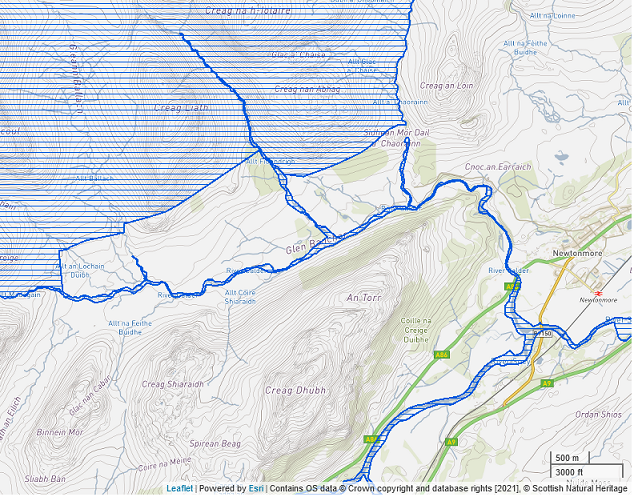
It would be a mistake for Highland Council to let the Glenbanchor Estate to get away with presenting unclear plans and do their job for them by concentrating on the risks to the SAC (which won’t be anything like those being caused by the repairs to the funicular). Instead, as part of their screening opinion, they should make it quite clear that while any road improvement/creation to the forest plantations would come under the Prior Notification system, the section of proposed road between Pitmain and Glen Banchor would need full planning permission.
Meantime, the application for this Screening Opinion adds to the argument that every landed estate in our National Parks should have to produce a single plan about how the owners intend to manage their land. On the Glenbanchor Estate peatland restoration and woodland restoration projects funded by us, the public, sit alongside intensification of sporting use and commercial management, both of which drive the construction of hill roads. It is impossible for any member of the public to form an overview of what is going on and my suspicion is that the CNPA in most cases don’t know how this all fits together either. That would be a good questions for Lorna Slater, the new Scottish Minister for National Parks (see here), to ask when she goes out to visit her new charges!
You wrote… “Meantime, the application for this Screening Opinion adds to the argument that every landed estate in our National Parks should have to produce a single plan about how the owners intend to manage their land.”
I could not agree more – what a sensible (and reasonable) suggestion for all national parks; the same issues surely apply in say Northumberland, the Brecon Beacons and those other parks where there is extensive estate ownership.
Should the above map be titled “Monadhliath Hills ” SAC. ?
It will be interesting to see whether the plantations will remain in place, or be removed in the interests of grouse, an interesting variety of Raptorial birds have nested in them at one time or another.
What a great pity Mr Polvsen did not purchase Cluny and Banchor, one of the very finest glens.
what a pity that the area is not at the very core of rewilding and conservation in Scotland and indeed Europe http://www.parkswatchscotland.co.uk/2016/04/25/monadhliath-national-wildlife-refugium/ ? fbclid =/w ARDAW9
Are you for real. People love that word, rewinding, but don’t realise the long term consequences. For one , unmanaged land has a massive fire risk. There is a good example of that at Blackmount just north of Carrbridge on the left hand side of the A9 heading north. The was a big fire in the mid 70s and it is only starting to repair itself, almost 50 years. I rest my case
Aye, Badenoch Birder ( aka Wullie Gruff the Gamie? ) I’m out there in the world of boreo-Arctic reality of a run down, boreo-temperate rainforest, now annually burned to hell, grazed to hell, quasi-feudal Victorian Edwardian Dystopia, run to suit the indulgences of a virtual land monopoly cabal. You may like to wallow in its fake ancient traditions, but rewilding ( not rewinding) and rewilders are gradually winning the battle to overcome the nightmare world created in the 19th century.
Annually burned, come now, the basis of your debate has already failed ooops
you say every estate should produce a management plan: in fact, this is one of the proposals from the scottish land commission. from memory, estates over 10000hectares. sle are critical of this.
‘The requirement for significant land holdings to publicly engage on, and publish, a Management Plan
A Land Rights and Responsibilities Review process, a practical means of review where there is evidence of adverse impacts
A new Public Interest Test that could determine whether significant land acquisitions create risks of concentrated power.’
https://www.landcommission.gov.scot/news-events/news/legislative-proposals-to-address-impact-of-scotlands-concentration-of-land-ownership?p_slug=news
What are you wanting to know like?